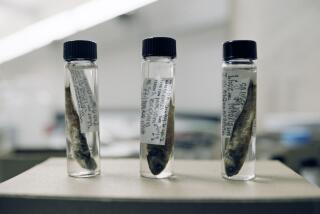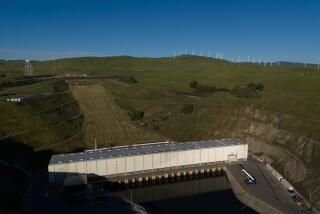One Fish, Two Fish, More Fish, Few Fish?
DRY TORTUGAS NATIONAL PARK, Fla. — In these warm, jade-colored waters two hours from the nearest port by fast catamaran, Ashley McCrea-Strub donned her black wetsuit and pink flippers. It was time to get back to her summer job as census taker of the sea.
To perform her tasks, the fourth-year doctoral student in marine biology and fisheries carried a pencil and a sheet of waterproof paper. To help her judge the size of what she could see in the turbulent, cloudy water, she had a measuring device that looked like a window washer’s squeegee.
For the next half-hour, breathing a mixture of gases that contained 36% oxygen, the 26-year-old Miami woman parked herself on the bottom of the Gulf of Mexico near the coral-encrusted wreck of a Norwegian sailing ship and listed all the fish she could see.
“Rather than counting things dead on the dock, we’re going into the water to see what’s here,” said Jerald S. Ault, associate professor at the University of Miami’s Rosenstiel School of Marine & Atmospheric Science, and McCrea-Strub’s academic mentor.
For 20 days, ending this month, researchers, employees and students from the National Oceanic and Atmospheric Administration, the University of Miami, Florida’s Fish and Wildlife Conservation Commission and other private and government agencies pooled their talents and efforts to carry out one of the most exhaustive surveys of marine life ever.
There was a lot to look for.
The Dry Tortugas, a cluster of seven islands of coral and sand, are at a crossroads of ocean currents that help make them a dazzling living museum for marine life, with spectacular deepwater corals and more than 250 species of fish.
Twenty-two divers, working off the 100-foot dive boat M/V Spree, were assigned to perform 1,600 dives at selected spots throughout nearly 125 square miles of coral reef habitat. Their assignment: Enumerate the population of fish and other ocean life, including the Florida spiny lobster, aquarium-sized masked gobi and the enormous, fierce-faced Goliath grouper.
Once the numbers of the fish seen are crunched and compared with results from past surveys, mathematical models will be used to help build an overall picture of whether the protected fish populations in the Dry Tortugas and Florida Keys are rallying after decades of overfishing.
“We’re trying to figure out how healthy it is -- the coral and the fishes,” said Jim Bohnsack, a supervisory research biologist with NOAA Fisheries who was instrumental in developing techniques used in the fish count. He likened the operation, which he and other scientists said was unprecedented in geographic scope and the variety of species covered, to an electrocardiogram of the sea.
The Dry Tortugas lie about 70 miles west of Key West, and can only be reached by boat or seaplane. Discovered by the Spanish explorer Ponce de Leon in 1513, they had plenty of sea turtles, tortugas in Spanish, to provision the conquistador’s ships with meat. But the islands lacked fresh water -- hence the word “dry” though surrounded by salt water.
The islands’ most notorious human inhabitant was Dr. Samuel A. Mudd, the physician who set the broken leg of President Lincoln’s assassin, John Wilkes Booth. Mudd was incarcerated in a fort that was converted to a prison after the Civil War.
Commercial fishing in what is now the park was banned in 1935; lobsters and conches have been protected since the 1970s. A dozen years ago, the area was designated a national park -- though its remoteness helps ensure that it is not a heavily visited one.
Since 2001, adjacent federal- and state-controlled waters have constituted the largest year-round no-fishing zone in U.S. territorial waters, 171 square miles of haven for marine creatures. The area is the ideal laboratory to gauge how such conservation measures function, and how far the benefits extend into unprotected seas, said Gary Davis, visiting chief scientist for oceans at the National Park Service.
“Everybody is looking for measures of performance for these no-take areas,” Davis said. Methods and data from the census should help determine the effectiveness of other no-fishing zones in U.S. waters, including at Channel Islands National Park off Southern California, Davis said.
According to marine biologists, the waters in and around the Florida Keys have long been under severe stress from southern Florida’s booming population and a 700% increase in recreational vessels over the last four decades.
Unlike in the era when writer Ernest Hemingway trolled for blue marlin between Cuba and Florida, modern technology, including acoustic locator devices to detect fish, faster boats and satellite-assisted navigation systems, has drastically improved the odds for anglers and lessened those of many species of fish.
“All these things are conspiring against the resource,” Ault told a group of visitors to the Spree.
In the 1940s, the professor said, the average size of a grouper hooked in the Keys was 22 pounds. Today, the Florida mealtime favorite is 8 pounds, meaning the average lifespan of the fish has dropped. That phenomenon, known to biologists as “juvenescence,” may be endangering the ability of the species to reproduce and ensure survival.
For census taker McCrea-Strub, being part of the project was the chance of a professional lifetime. “I could never give up an opportunity like this,” she said. “The Dry Tortugas -- it’s pristine compared to the rest of the Florida Keys. Everything is just on a grander and bigger scale.”
The teams of divers remained stationary and counted fish in an imaginary column of water, noting each animal’s size and position. Their tallies will be averaged and massaged with statisticians’ algorithms to minimize human error.
On the Dry Tortugas expedition, census takers made as many as five 30-minute dives a day, a workload McCrea-Strub called exhausting but worth it in terms of science.
“Most fisheries research is based on what the fishermen are catching,” she said. “That’s such a biased view.”
One innovative gadget used, the brainchild of scientist Jiangang Luo of the University of Miami, was designed to help the counters judge the size of fish seen at a distance. It projects an array of parallel laser beams through the water onto the body of a fish, helping divers estimate its length.
There has been some good news from preliminary results of the census, Ault said after divers had completed two-thirds of their dives: The Keys grouper population may be rebounding, and the size and abundance of coral were greater than expected. “I think things are moving in the right direction,” he said.
At 90 feet, a large hawksbill turtle tried to squeeze between McCrea-Strub and the ocean floor. The grad student, who has been a scuba diver since she was 16, also had close encounters with large moray eels and barracuda.
On a single dive, McCrea-Strub sighted and listed a score of species, including blue tang, striped parrotfish and several varieties of snapper. “That’s a good day,” she announced after returning to the surface, where a lunch of tuna noodle casserole and sliced watermelon was waiting in the dive boat’s galley.
More to Read
Sign up for Essential California
The most important California stories and recommendations in your inbox every morning.
You may occasionally receive promotional content from the Los Angeles Times.










